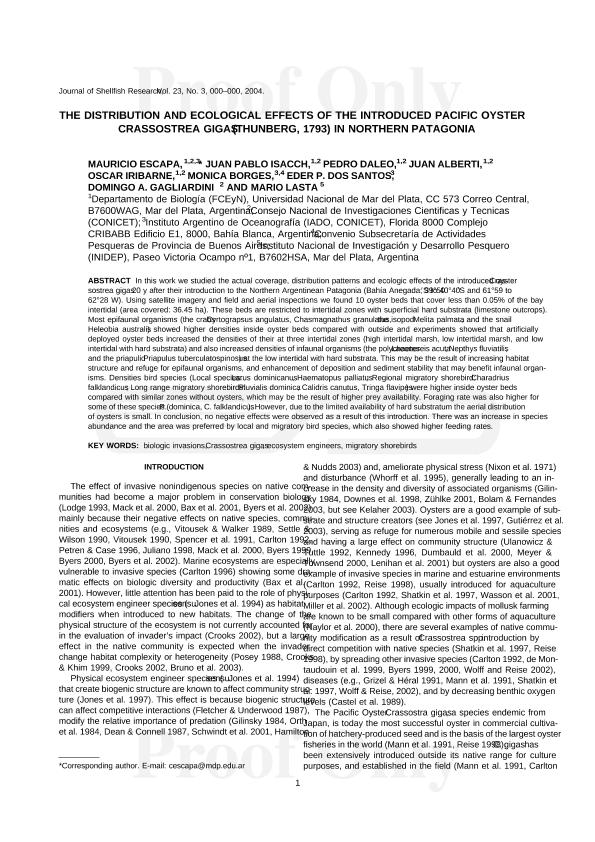Mostrar el registro sencillo del ítem
dc.contributor.author
Escapa, Carlos Mauricio

dc.contributor.author
Isacch, Juan Pablo

dc.contributor.author
Daleo, Pedro

dc.contributor.author
Alberti, Juan

dc.contributor.author
Iribarne, Oscar Osvaldo

dc.contributor.author
Borges, Mónica Elisa

dc.contributor.author
Dos Santos, Eder Paulo

dc.contributor.author
Gagliardini, Domingo Antonio

dc.contributor.author
Lasta, Mario
dc.date.available
2017-12-11T13:49:26Z
dc.date.issued
2004-12
dc.identifier.citation
Escapa, Carlos Mauricio; Isacch, Juan Pablo; Daleo, Pedro; Alberti, Juan; Iribarne, Oscar Osvaldo; et al.; The distribution and ecological effects of the introduced Pacific oyster Crassostrea gigas (Thunberg, 1793) in Northern Patagonia; Natl Shellfisheries Assoc; Journal Of Shellfish Research; 23; 3; 12-2004; 765-772
dc.identifier.issn
0730-8000
dc.identifier.uri
http://hdl.handle.net/11336/30102
dc.description.abstract
In this work we studied the actual coverage, distribution patterns and ecologic effects of the introduced oyster Crassostrea gigas 20 y after their introduction to the Northern Argentinean Patagonia (Bahia Anegada; 39º50´S to 40º40´S and 61º59 to 62º28 W). Using satellite imagery and field and aerial inspections we found 10 oyster beds that cover less than 0.05% of the bay intertidal (area covered: 36.45 ha). These beds are restricted to intertidal zones with superficial hard substrata (limestone outcrops). Most epifaunal organisms (the crabs Cyrtagrapsus angulatus, Chasmagnathus granulatus, the isopod Melita palmata. and the snail Heleobia australis) showed higher densities inside oyster beds compared with outside and experiments showed that artificially deployed oyster beds increased the densities of their at three intertidal zones (high intertidal marsh, low intertidal marsh. and low intertidal with hard substrata) and also increased densities of infaunal organisms (the polychaetes Laeonereis acuta, Nepthys fluviatilis, and the priapulid Priapulus tuberculatospinosus) at the low intertidal with hard substrata. This may be the result of increasing habitat structure and refuge for epifaunal organisms, and enhancement of deposition and sediment stability that may benefit infaunal organisms. Densities bird species (Local species: Larus dominicanus, Haematopus palliatits: Regional migratory shorebird: Charadrius falklandicus; Long range migratory shorebirds: Pluvialis dominica, Calidris canutus, Tringa flavipes) were higher inside oyster beds compared with similar zones without oysters, which may be the result of higher prey availability. Foraging rate was also higher for some of these species (P. dominica, C. falklandicus). However, due to the limited availability of hard substratum the distribution of oysters is small. In conclusion, no negative effects were observed as a result of this introduction. There was an increase in species abundance and the area was preferred by local and migratory bird species, which also showed higher feeding rates.
dc.format
application/pdf
dc.language.iso
eng
dc.publisher
Natl Shellfisheries Assoc

dc.rights
info:eu-repo/semantics/openAccess
dc.rights.uri
https://creativecommons.org/licenses/by-nc-sa/2.5/ar/
dc.subject
Biologic Invasions
dc.subject
Crassostrea Gigas
dc.subject
Ecosystem Engineers
dc.subject
Migratory Shorebirds
dc.subject.classification
Otras Ciencias Biológicas

dc.subject.classification
Ciencias Biológicas

dc.subject.classification
CIENCIAS NATURALES Y EXACTAS

dc.title
The distribution and ecological effects of the introduced Pacific oyster Crassostrea gigas (Thunberg, 1793) in Northern Patagonia
dc.type
info:eu-repo/semantics/article
dc.type
info:ar-repo/semantics/artículo
dc.type
info:eu-repo/semantics/publishedVersion
dc.date.updated
2017-11-21T13:55:44Z
dc.journal.volume
23
dc.journal.number
3
dc.journal.pagination
765-772
dc.journal.pais
Estados Unidos

dc.journal.ciudad
Washington
dc.description.fil
Fil: Escapa, Carlos Mauricio. Consejo Nacional de Investigaciones Científicas y Técnicas. Centro Científico Tecnológico Conicet - Bahía Blanca. Instituto Argentino de Oceanografía. Universidad Nacional del Sur. Instituto Argentino de Oceanografía; Argentina. Universidad Nacional de Mar del Plata; Argentina
dc.description.fil
Fil: Isacch, Juan Pablo. Consejo Nacional de Investigaciones Científicas y Técnicas; Argentina. Universidad Nacional de Mar del Plata; Argentina
dc.description.fil
Fil: Daleo, Pedro. Consejo Nacional de Investigaciones Científicas y Técnicas; Argentina. Universidad Nacional de Mar del Plata; Argentina
dc.description.fil
Fil: Alberti, Juan. Consejo Nacional de Investigaciones Científicas y Técnicas; Argentina. Universidad Nacional de Mar del Plata; Argentina
dc.description.fil
Fil: Iribarne, Oscar Osvaldo. Consejo Nacional de Investigaciones Científicas y Técnicas; Argentina. Universidad Nacional de Mar del Plata; Argentina
dc.description.fil
Fil: Borges, Mónica Elisa. Consejo Nacional de Investigaciones Científicas y Técnicas. Centro Científico Tecnológico Conicet - Bahía Blanca. Instituto Argentino de Oceanografía. Universidad Nacional del Sur. Instituto Argentino de Oceanografía; Argentina
dc.description.fil
Fil: Dos Santos, Eder Paulo. Consejo Nacional de Investigaciones Científicas y Técnicas. Centro Científico Tecnológico Conicet - Bahía Blanca. Instituto Argentino de Oceanografía. Universidad Nacional del Sur. Instituto Argentino de Oceanografía; Argentina
dc.description.fil
Fil: Gagliardini, Domingo Antonio. Consejo Nacional de Investigaciones Científicas y Técnicas; Argentina
dc.description.fil
Fil: Lasta, Mario. Consejo Nacional de Investigaciones Científicas y Técnicas. Centro Científico Tecnológico Mar del Plata. Instituto de Investigaciones Marinas y Costeras. Subsede Instituto Nacional de Investigación y Desarrollo Pesquero; Argentina
dc.journal.title
Journal Of Shellfish Research

dc.relation.alternativeid
info:eu-repo/semantics/altIdentifier/url/https://archive.org/details/cbarchive_38899_thedistributionandecologicalef1981
Archivos asociados
